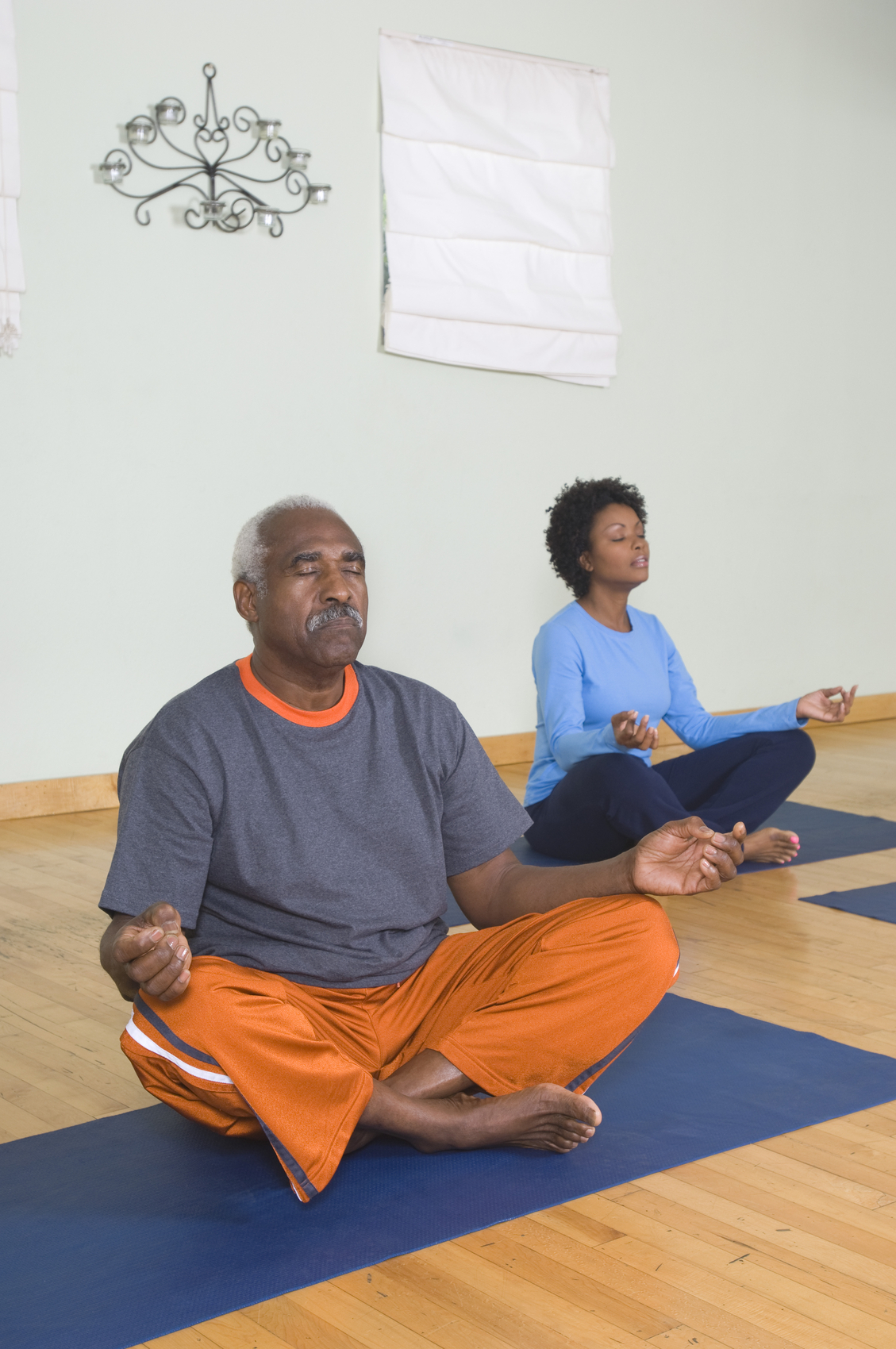Yoga is very popular and is cited as a favorite non-medical therapy by many people living with Parkinson’s disease (PD). People are often fearful of getting started in a yoga class since there is often an incorrect portrayal of yoga in the media as being only for flexible, skinny ballet dancers. Yoga, on the contrary, is a very adaptable practice, with both functional and psychosocial benefits, that can be suited to a wide variety of abilities.
Yoga has become synonymous with holding and moving between a series of static postures (called asanas); however, this physical practice (called hatha yoga) is only one part of the larger lifestyle of yoga framework that includes branches such as philosophy, chanting and selfless service. Hatha yoga combines physical postures to address strength, flexibility, balance and mind-body-breath connection. Breathing practices (pranayama) and meditation are included to develop greater self-awareness and can have tremendous benefit on the mental state.
What do we know about yoga in Parkinson’s disease?
A review of the scientific literature shows a few studies that support hatha yoga for people with PD. This is an area of research that is just starting to build evidence. What studies do exist suggest modest benefits for:
- Mobility: The issue of mobility has important implications for fall prevention in PD. Yoga participation can improve functional mobility and influences how a person with PD walks. Standing yoga poses target the hip extensor, knee extensor and ankle plantar flex-or, which support center-of- gravity during walking and may improve overall stability.
- Balance: Balance training is an important component of PD therapy, because 40 percent of nursing home admissions are preceded by a fall. Research shows yoga-related improvements in balance (tandem, one-leg) and an associated decrease in a person’s fear of falling; this can also help keep people with PD active in their communities.
- Strength: Gains in lower-body strength occur for PD patients following yoga practice and are associated with improved postural stability. Yoga requires isometric contraction (i.e., the joint angle and muscle length do not change) of specific muscle groups to stabilize the body as one performs the postures, and may mimic isokinetic contractions (i.e., variable resistance to a movement per-formed at constant speed) when performing controlled systematic movements from one pose to the next. These mechanisms may be the reason why yoga improves muscular strength.
- Flexibility: Improvements in flexibility and range of motion (ROM) are important since rigidity is a common clinical manifestation in PD. Research shows improvements in flexibility/ROM of the shoulder, hip and spine. Stooped posture is common in PD and can be related to short spinal flexors and weak spinal extensors; improved shoulder and spinal flexibility from yoga supports a more upright posture. Greater hip mobility from yoga may translate into improvements in shuffling gait which can be commonly seen in PD.
- Mood & Sleep: The psychosocial benefits associated with yoga are important for disease management, as they are not often addressed with classic medications used to replace the neurotransmitter dopamine in PD. Many classic medications used to treat anxiety are not safe in PD patients. The calming effect of yoga (by enhancing parasympathetic output) may lessen perceived stress, enhance relaxation, and bene-fit sleep in PD. Many patients with PD have apathy and fatigue which anecdotally are helped with yoga. Since the mind and the body are very connected in PD, any mental state benefits are tangibly translated into motor benefits. A yoga class can offer a support group, improved confidence and self-efficacy. Caregivers can also participate and reap the rewards in the psychological realm as well.
Not everyone is lucky enough to live near a yoga instructor who has a deep understanding of PD – this makes it important to educate yourself, both about your specific PD needs and how yoga postures can help, so you can feel comfortable and confident with utilizing the yoga resources that are available in your own community.
Yoga can benefit people with Parkinson’s both physically and cognitively!
Yoga is both physically and cognitively engaging by focusing on body-awareness during complex body positions. Yoga postures improve physical strength, flexibility, and balance. Yoga postures are also considered skill-acquisition exercises and can benefit our brains thinking patterns and processes to make our movements more efficient and effective.
Yoga helps to increase muscle mass that is useable in everyday life by focusing on functional movements. For example, one-leg balance poses (i.e. tree pose) are helpful for climbing stairs; chair pose builds core and leg strength to help you get up out of bed and/or out of a seated position.
Yoga is actually a form of cueing/attentional training.
The ability to move in Parkinson disease is not lost; rather the brain mechanisms that initiate movement are defective. Attentional training/cueing may provide a non-automatic drive for movement, which may compensate for this faulty brain circuity and improve performance. Yoga breaks up complex sequences and/or postures into component parts, enabling a person to focus their attention on individual aspects of the posture and improve performance. Specific external cues given during a yoga class can also benefit performance in persons with Parkinson disease.
- Utilize visual cues (i.e., watch the yoga instructor or use a mirror) to help you coordinate your movement.
- Utilize props (i.e., blocks, straps, chairs) to get the experience of the full movement safely, and then take supports away as you progress.
- Talk to your yoga instructor about giving you hands-on adjustments while performing the poses. Subtle adjustments can help you with proper alignment and ensure you are not putting your body in a position that could be painful or result in injury.
- Focus on one aspect of the pose at a time to maintain your attention on your body in the present moment.
Know that yoga can both improve and aggravate your Parkinson’s symptoms!
To avoid aggravating your symptoms, let your yoga instructor know that long holds may increase stiffness or muscle cramping. Instead of holding postures in stillness, try to move into the posture on an inhale breath, and relax out of the posture on an exhale breath. Yoga postures can be beneficial and improve rigidity, stiffness and slowness, especially in the chest muscles and spine. Focusing on yoga poses that safely extend the spine and/or deep diaphragmatic breathing exercises can create space in the chest and improve posture. Many of the floor poses in yoga allow you to practice getting up safely off the floor. This practice can increase confidence, reduce the fear of falling and increase the likelihood that you can get back up on your own if you do fall. Practice in the company of a care-giver first at least twice per day. You can use two stable supports one on either side at first if needed.
Use yoga as an opportunity to focus on posture
Stooped posture in Parkinson disease is common. It is attributed to shortened contracted spine flexors and weak extensors of the spine. Asymmetry of stiffness can lead to misalignment and can lead to misuse and disuse of muscles that can further worsen posture.
What can yoga do?
- Strengthens your core, especially your transverse abdominal muscles
- Lengthens your psoas muscle… a thick muscle that runs from under your armpits to your hips and connects your legs to your torso.
- Encourages gentle backbends to open upper spine
- Creates self-awareness, and good habits, around how you hold your body in standing posture.
About the Authors:
Kaitlyn P. Roland completed her PhD research at the University of British Columbia (2012), which measured Parkinson’s disease-related changes to daily muscle activity and consequences for physical function and frailty. She is currently a postdoctoral fellow at the University of Victoria¹s Centre on Aging and her most recent work examines care needs and well-being in PD dementia caregivers.
Dr. Indu Subramanian received her medical degree in 1996 from the University of Toronto, Canada. She is clinic director at the Greater Los Angeles Veterans Administration medical Center and directs clinical drug trials for the treatment of Parkinson’s Disease.
Topics in this story
More Stories
Black Lab Raisin reminds Veterans of life outside the hospital, brightens their lives with her endless capacity for joy.
VA remains open for business and is closely monitoring the Change Healthcare (CHC) cybersecurity incident.
Take the stress out of travel. My HealtheVet makes preparing for your time away easy with these five quick tips.









They should watch this video it inspired me.
https://youtu.be/bIXOo8D9Qsc